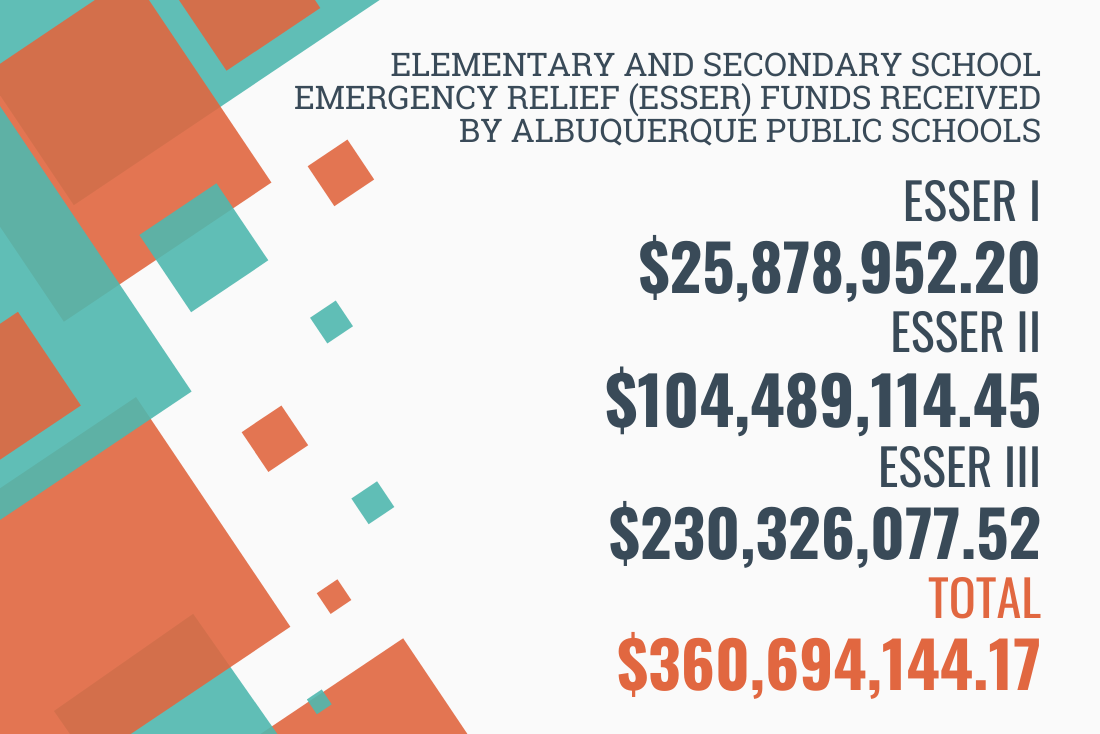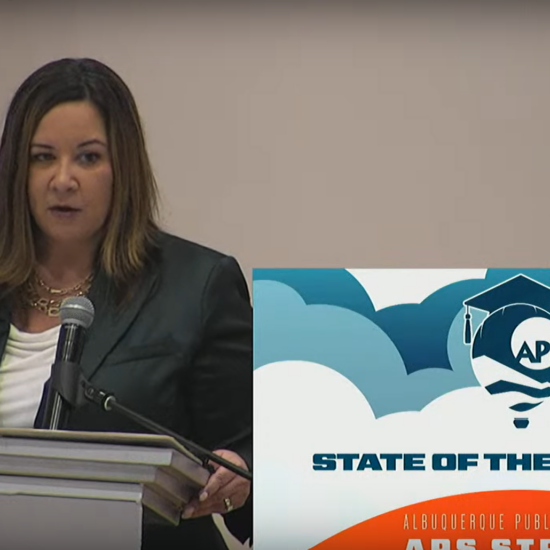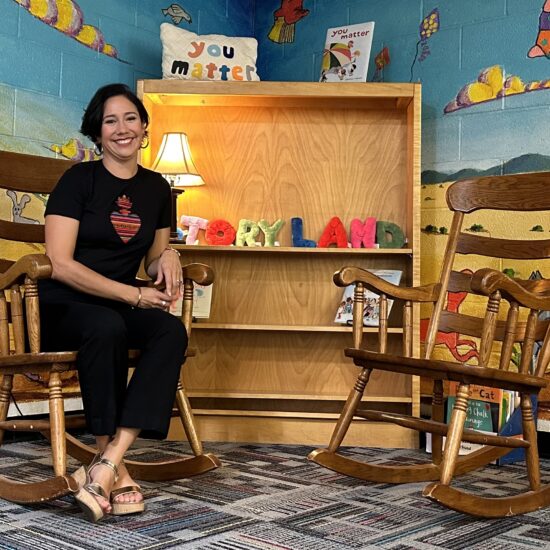
Albuquerque school board members pointedly questioned district staff Wednesday night about how $230 million in federal Covid relief funds are being spent, after reading two critical internal memos that have been posted on the district website for several weeks. (You can read the memos here and here.)
Significant portions of the federal funds granted to Albuquerque Public Schools are being spent in an uncoordinated fashion apparently not tied to the district’s strategic plan or even guaranteed to reach the students who need it most, the memos say.
They were written by the district’s Progress Monitoring Committee, a team of senior district officials and outside consultants assembled to oversee American Rescue Plan Act (ARP) spending.
APS Superintendent Scott Elder seemed displeased that school board members had seen the memos. “These are internal documents. I’m a little surprised that these are the ones we pulled out for you because there are others,” Elder said during Wednesday’s meeting.
But board member Crystal Tapia-Romero said information contained in the memos is exactly what she and her colleagues should be seeing. “Honestly, I’m grateful these are the memos that were pulled out,” she said, adding that the findings in the memos were “extremely concerning to me.”
She said the memos painted a much less rosy picture of the district’s federal relief spending than a presentation board members heard from senior district officials during Wednesday’s meeting.
Tapia-Romero’s thoughts were echoed by board member Courtney Jackson, who praised committee members for their forthrightness. “I’m thrilled that these progress monitoring committee meeting notes were included…because while it was disappointing to read through this and to see that there was a lack of confidence, I’m also grateful to the PMC for telling us the truth and for being willing to say we might need to pause on this.”
The memos say there is little evidence that the money is creating or enhancing programs reaching the district’s most challenged students.
“Most of the funding is district-led and expended and, if distributed to the schools, it is through a process that is inconsistent or not determined to ensure that students identified in law or students defined as “Yazzie-Martinez,” or even at high poverty schools, receive the funds, or funded services, with intention,” says a memo dated Feb. 2, 2022.
In somewhat oblique, polite language, the memo suggests that the district put the cart before the horse, approving funding for projects that had not been fully vetted or fleshed out. “In the spirit of transparency and efficiency, our committee learned that some of these activities have already started, some of the positions have been funded with other dollars with plans to shift to federal funding,” the memo says.
“The PMC was given the charge to “greenlight” all projects before funding flowed,” according to the memo.
In its March 1 memo, the committee’s tone grows markedly more critical.
“…funding for these projects lacks strategic coherence and though they all fund “good” ideas and programs, there are very few that fund programs that “work,” in that none can guarantee any improved outcomes for students or educators,” the memo says.
It continues: “The American Rescue Plan is more than an opportunity to respond to crises and fill budgetary gaps or address short term crises. The $230 million to APS from the ARP should be focused on how we are putting money to use to create something better for educational policy or work to directly impact student outcomes.”
The March memo also flags what it terms a “troubling trend” of funded projects being disconnected from senior district officials, and that “most of the funding is directed towards good and passionate ideas that are either optional or not intentionally targeted to those students or schools that most need the resources and services.”
The U.S. Department of Education requires school districts to engage a broad spectrum of communities and stakeholders as it decides how to use federal rescue plan funds. It also requires “Grantees (to) submit an annual report describing how the State and sub-recipients used the awarded funds during the performance period.”
APS has exceeded those requirements by creating the monitoring committee and posting its memos, questioning the district’s expenditures to date, on its website.
The committee was formed to “monitor transparency, efficiency and the use of data-based decision making throughout the duration of this funding,” which is to be spent by September 2024, according to the APS website.
It consists of eight senior administration officials and two external members, including Chief Operations Officer Gabriella Blakey, Director of Charter Schools Joseph Escobedo, Associate Superintendent Antonio Gonzales, Jason Espinoza and Art Melendres.
Despite the list of heavy-hitters, the committee says in its memos that some people responsible for programs funded or enhanced by the relief dollars have not responded to requests for interviews on how the money is being spent.
The district identified 43 projects for rescue plan funding. In its February memo, the committee reported it had interviewed leaders of 23 of those projects, and that 11 interview slots had been offered but were “unclaimed.”
In its March 1 memo, the committee reported that it had “offered two days in February with the goal of finishing the first stage of project start-up interviews. There are eight projects that either did not sign up for an interview time or we have not dedicated separate time to understanding the scope of the work provided with the funding.”
APS placed rescue plan finding priorities under five categories: unfinished learning initiatives, social emotional and mental health services, technology initiatives, facility projects, and safe operations of schools with COVID precautions. Money was also set aside for “future planning.”
The biggest-ticket items selected for rescue plan funding include:
- Support for extended time, principal coaching and principal mentorship at 34 schools: $28 million (unfinished learning)
- Health and safety facilities upgrades: $28 million
- Professional development for educators: culturally and linguistically responsive instructional materials: $16.5 million (unfinished learning)
- Eight-hour (extended) professional workday pilot; $12 million (future planning)
- Expansion of elementary “summer learning adventures:” $11.4 million (unfinished learning)
- Chromebooks and “other devices”: $9 million (technology initiatives)
At Wednesday’s meeting, board member Danielle Gonzales asked whether the district has data showing how many of the district’s youngest students are lagging far behind in reading, so that funding can be targeted to those students.
Chris West, APS’ executive director of strategic analysis and program research, said that assessments given last December show that 41 percent of students in kindergarten, first and second grade “fall into that critical care category,” meaning they are at least a year below grade level.
“So target this money there,” board member Peggy Muller-Aragón said. “I want to know how hard that is going to be for you to do.”
Elder replied that “we know who the kids are,” but added that the assessments West referred to “aren’t always used consistently across the district.”
Muller-Aragón said she wasn’t satisfied with the district’s response. “I don’t know that you have sold me on how this money is being spent to benefit our kids,” she said. “It’s time to align and refine these priorities.”







